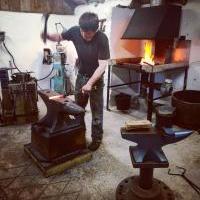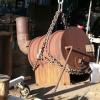-
Posts
50 -
Joined
-
Last visited
Profile Information
-
Gender
Male
-
Location
Ottawa, Ontario
-
Interests
Knife making, forging, metal working, etc
Recent Profile Visitors
541 profile views
-

What did you do in the shop today?
apexmateria replied to Mark Ling's topic in Blacksmithing, General Discussion
cut a piece of steel off an old wood stove, going to bolt it to my workbench.. I need to cut another slab off tomorrow, which I'm not looking forward to. I don't have the right tool so it takes forever. -
Any chance you could do a very basic image to explain the exhaust port concept? I can't visualize what you mean unfortunately. I don't have a block of copper but I do have enough 2-3" pieces of 1mm thick cut copper wire that could fill the square 10" steel vessel. Steel mesh could hold the copper pieces in place. Copper doesn't have any issues with giving off dangerous vapors at high heat right? Ideally I'd like material that radiates heat for long periods of time so I don't have to make fires often. I work for 4-5 hours at a time, my work space is roughly 10 feet squared with no insulation and a crappy tin door that lets winter air in through the cracks . To make it even worse I need to mount the heater at should level because I have no space on the floor for it. I'm not sure I'll have enough mass to actually heat the room, it should be interesting to see if it actually works. PS - You asked about how I thought up the design earlier and completely forgot to mention this guy: It's basically a modified version of that. Just wanted to make sure he gets credit.
-
^ Thanks I'll try preheating the metal before I do any welding today. I've been using a large steel brush on a drill to clean the metal I'll try grinding.
-
Thanks George for the helpful criticisms. You're right the fire area is very small and will require attention every few minutes. My hope is that the mass is small enough that it will heat up very quickly and radiate out lots of heat so I won't need to keep a fire going for long periods of time. If I had to remake it I'd definitely go with a gravity fed J-burner design instead of the L shaped burner I have now. That's a good point about the exhaust potentially not being able to move through the system. I considered it as well and I'm just not sure. What I'm going to do is put lots of clay around that entire area temporarily to see if it works, if it doesn't I can pull it off and try only insulating the center pipe. It's too expensive to buy a large aluminum brick and I think it might melt. The guys who build rocket heaters seem to use cob (clay / sand / hay mixture) as the heated mass. They have huge areas of mass to store heat while I only use a very small area by comparison, so mine needs to be as efficient as possible. If you have any other ideas about what would make a good heater block please let me know! Consider the temps get VERY high. Basically I just researched rocket mass heaters for a few hours to understand how they work, then tried finding a really small one to copy but couldn't find anything like what I wanted so I just made up a custom design. - Steve - yea those welds are terrible lol. Not like my skill level is great but my welding setup is very bad. My machine is cheap and under-powered, it can barely strike an arc and the welds barely penetrate. I welded some feet on the bottom of the L burner and those were some of my nicest welds yet, but I could easily snap the piece off. When I tested the 48 amp welder at a friends house it was like night and day difference. For the press I'm going to try constructing it with very minimal reliance on welds (I'm thinking about using 2x 1/2" steel brackets and industrial bolts on each side to secure the central plates).
-
Good advice thanks, I'll certainly do that. I'll be using hardwood as fuel. It's a bit hard to explain but I'll give it a shot, here are some pictures to help. This first pic shows how the central pipe is cut open to allow cooler air to drop down and pass into the secondary pipes towards the exhaust: 10/10 welds? How it's supposed to work is that there's an extremely well insulated fire in the center of the tank. The heat travels up the center pipe and heats the top block which carries a decent amount of clay and steel mass - it radiates out heat. The cooler temperature exhaust travels down into the adjacent exhaust tubes welded onto the central one. The exhaust is shot back into the propane tank where it is pushed into the external exhaust, and finally out the chimney. All central pipes should be quite well insulated. I'm considering either using ceramic blanket and castable refractory on the pipes directly under the heater core or cob. I think I'll probably go with cob since there's less chance it gives off any nasty fumes or particles.
-
UPDATE: Got very delayed on the press because I've been setting up a new workshop. I'm building a micro rocket mass heater to keep things toasty in the winter, it doesn't have the heat core and exhaust welded on, still needs lots more work. I've never seen a mass heater this compact and the design is experimental so it will be interesting to see if it actually works. My welder at the moment is 20 amp running on 15 so it's making the project drag on longer than expected. It makes it hard to sustain an arc. I have a more powerful 48 amp welder to use but I'm waiting on an adapter. I have no need for a 90 ton press at the moment but there's no telling what I might want to use it for in the future. I'm getting into custom metal fabrication and automation. Was thinking of converting the press to run on 3 phase power in the spring, I want to try to automate sheet metal stamping.
-

90 Ton Hydraulic Press For Under $500 [Mockup]
apexmateria replied to apexmateria's topic in Presses
The bottle jacks arrived, had to special order them for some reason. $99 CAD/unit seems dirt cheap. The metal frame for the press is soaking in vinegar to remove the rust. I still need to source more plate. Going to the salvage yard tomorrow.. -
Commercial link removed as per TOS I managed to find some castable refractory locally (heatcrete 27 m) it's $60 a bag.. I'm concerned about the max temp rating of 2700F I could buy some Kastolite 30li plus -- but it will cost around $140 for the bag with shipping - it's rated at 3000F Will heatcrete 27 be ok? Anyone have experience with this product? Does it do well to resist borax? Can handle forge welding temps over long periods of time?
-

90 Ton Hydraulic Press For Under $500 [Mockup]
apexmateria replied to apexmateria's topic in Presses
The reason I mentioned that example was because I just watched a guy do it on video. He used a manual 4 ton jack inside a very simple welded frame and he punched through 2-4mm cold steel plate clean and easy (it warped the surrounding metal a bit but overall it was a clean punch). In the same setup guys are easily crushing 2mm thick rectangular stock (1" diameter) into a flat bar. With 20x the crushing power of their setup (and a much, MUCH beefier frame) I think I can push a billet together. I maybe wrong, and I'm very open to admitting that. I'm ok with learning through failure as long as 1) it's only time and money on the line 2) I don't get seriously injured or die. I believe there's enough possibility of success to give it a try. I'll update sometime in the coming weeks! -
Even just touching the bars puts little specs of chrome onto my fingertips (because the rust is slowly flaking it off). Kind of a shame because it's so much metal that would be useful for projects, it is what it is though! Thanks guys, appreciate you helping me out. I won't grind or cut them. I'll find a safe use for them one day.
-

90 Ton Hydraulic Press For Under $500 [Mockup]
apexmateria replied to apexmateria's topic in Presses
Frosty don't worry I'm not planning to win a Darwin award anytime soon! I'll ask you guys for advice along the way to make sure it's as safe as possible. My cousin is a talented machinist so he can help me too. Thick steel and very large industrial grade bolts will be used. I'll try my best to make sure it's very basic but safe. ThomasPowers I don't know almost anything about physics or thermodynamics but if I hammer a cold 4mm thick piece of mild steel plate 50 times it will be slightly dented up, if I create a punch using a 4 ton jack it will tear straight through the cold metal in seconds (very easily and quickly with much less effort). Something to do with leverages, gearing and concentration of force I think. I don't really understand it and haven't looked into it much. Same principle may apply to crushing a billet? -
Thanks for the help Frosty, dealing with metal vapors sounds slightly terrifying I'd prefer to avoid that https://multimedia.3m.com/mws/media/40744O/3m-respirator-cartridge-and-filter-selection-poster.pdf Is the 3M 6001i a suitable mask? Should I maybe strip off the chrome before grinding instead? I see there are some methods floating around using acids or electrolysis.
-

90 Ton Hydraulic Press For Under $500 [Mockup]
apexmateria replied to apexmateria's topic in Presses
I'm really curious how it would move the steel as well. From the videos I've seen a modified 20 ton log splitter will compress a billet like butter. I'm get you though, even at 90 tons the manual jacks seem like they might not perform well. I wonder how much force I'll have to exert on the jack on each stroke (while its compressing a large billet) because it needs to go up and down FAST, repeatedly, multiple times per second for the cylinder to move at a decent rate. I could definitely see the project ending in failure, but I do think there's maybe potential for success. Spreading the load across 3 jacks might really help if I can make it feel seamless. Next issue is the cost of the frame is it possible to make a stable frame for around $150? I'd need thick blocks of metal for the press plates as well. Any recommendations are appreciated. -

90 Ton Hydraulic Press For Under $500 [Mockup]
apexmateria replied to apexmateria's topic in Presses
Can open and close the 3 bleed release valves based on a lever of some sort. I played around with a bottle jack in my garage and it seems possible. If I get strong springs to pull down the cylinder it should only take a second to drop 1 centimeter and then I can rotate the billet, quickly shut the valve in 1 pull and start pressing again. Manual jacking is slow but it's especially bad to have to jack up the full length of the cyclinder. Jacking 2-4 CM of total distance doesn't take long from my test on an old 3 ton bottle jack. If I go really fast I can do 1CM of distance in 1 second. I'm getting the itch to try and make it.




